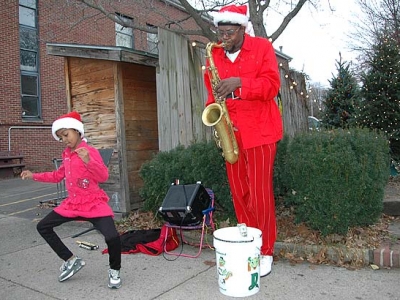Village Mediation mends village fences
- Published: April 17, 2014
Once upon a time in Yellow Springs, a local resident noticed that a drainpipe funneling water from a neighbor’s property onto hers had mysteriously appeared at the edge of her yard. The neighbors had never spoken about stormwater issues and the resident, uncomfortable with starting such a conversation, decided to simply reverse the direction of the pipe, sending the water back to its apparent source. Several months later, she noticed the drainpipe had been reaimed toward her property and she let the issue rest, resigned to more puddles in her yard during heavy rains.
The Village Mediation Program was erected in the 1980s to give residents a tool to address such situations. Since then, a group of 12–15 trained volunteer mediators from the community have made themselves available to bring interested parties together to talk out their differences. This year the mediator group is looking for new volunteers to help manage the average case load of one to two mediations per month, and they have organized a free two-day training program for anyone interested in either becoming a volunteer mediator or gaining skills in conflict resolution.
One question villagers have for Village Mediator Coordinator John Gudgel has been if the training is organized in response to the high number of current conflicts in the village. According to Gudgel, the answer is, “not at all.”
“One neat thing about Yellow Springs is that people are eager to resolve disputes face to face without legal involvement or police intervention,” Gudgel said. “Many of us practice mediation without knowing it, and the workshop could be a reaffirmation of what they’ve been doing.”
Village Mediation has provided many public training opportunities in the past, and this one will be led by local resident Janet Mueller, a 15-year Village Mediation volunteer and current contract employee of the Dayton Mediation Center. The sessions are scheduled for Saturday, April 19, and Saturday, May 3, both from 9 a.m. to 5 p.m. at Antioch University Midwest, one of the four project sponsors, along with Antioch College, Yellow Springs Community Foundation and the Village. Lunch and light snacks will be provided. Participants interested in attending are asked to register by calling 605-8754 or emailing mediation@yso.com.
Mueller and a team of Dayton mediators will focus the training on a technique known as transformative mediation, in which the transformation of the interaction between the parties in conflict is what matters most — even more than “resolving” the conflict issue. The first session in April will start with understanding the nature of conflict and how conflict can affect people’s ability to communicate clearly and openly with one another. Guides will use exercises and small group discussions and also talk about the mediator’s role to support improved communication.
“In Yellow Springs in particular we have high expectations for our conversations, so there is a need for skill in that area,” Mueller said. “Understanding conflict helps us to be patient and be more aware of our interactions.”
The session in May will focus on applying the concepts in practice through role playing and other exercises.
As a mediator, Mueller said, the important thing to remember is that it’s not the perspective of the mediator that matters.
“It’s not about me or what I think is right, or even what I’m noticing about each party,” she said. “It’s not the fixing of the problem — it’s them getting to that solution on their own, their process, that helps them take that solution beyond the mediation room.”
Gudgel has noticed several things about the nature of conflict for people at any age or station. The first is that conflict almost always involves people who are unable or unwilling to take the time to address issues face to face. As a former guidance counselor, teacher and principal of Yellow Springs High School and the current guidance counselor at Mills Lawn School, Gudgel has learned a lot from his interactions with youth. Kids engaging in what he calls “kid talk” about one another is immediately reframed when the kids come together face to face and witness in person the emotional effects their actions can have on one another.
“When kids sit down face to face, the mask is off … when you sit them down together, everything changes — I’m seeing the hurt on this person because of what I did,” he said. “Kids respond to the methods, I see it work time and time again.”
The topic of the conflict doesn’t matter, Gudgel said, and neither does the age.
“You’d be amazed in the similarities between the conflicts of a third grader and people in their 40s and 50s,” he said.
And likewise, when adults take the time to face each other and interact in a calm and rational manner to resolve their differences, the results are often positive.
“People are so emotionally vested in making sure they’re right — our world is so competitive and based on instant gratification,” he said. “There is a lack of sharing and empathy for one another, and it’s just about, ‘I’m going to slam dunk you.’”
Village Mediation has maintained an active option for local residents seeking help in addressing any kind of conflict, including disputes between landlord and tenant, neighbors, family members and businesses. The program also takes reference cases from the police, if the parties involved agree to mediation. Not every case gets mediated. According to long-time mediation coordinator Len Kramer, the program has always received about twice as many inquiries to mediation as actual mediations. Those that do agree to mediation can usually resolve their conflict in one session, but can sometimes take as many as two or three. Kramer has also seen a lot of success with the program.
“We set up a safe, confidential space for people to talk about the issues they have, and it works,” he said. “We elicit stories about the issue, and once that happens, invariably people can come up with their own solutions.”
Village mediators don’t have to be professionals in the field. Most of the current squad of volunteers have day jobs. But mediators do have to be willing to listen to others.
“There is no particular profile we’re looking for,” Mueller said. “People can come with very little experience as long as there is interest.”
One Response to “Village Mediation mends village fences”
The Yellow Springs News encourages respectful discussion of this article.
You must login to post a comment.
Don't have a login? Register for a free YSNews.com account.
Parkinsons.jpg)















Mediation is fine if all parties to a conflict are equal in power or status. When there is a power or status difference between parties to a dispute, mediation is the wrong tool. You can’t mediate domestic violence or child abuse or bullying in the workplace. When there is clearly a perpetrator-initiator and an involuntary target, mediation further hurts the victim. When a mediator believes a victim who fights back is equally at fault with a bully, mediation doesn’t work. Unfortunately, I have seen too many instances where the powerful hide behind the principal of transformative mediation.